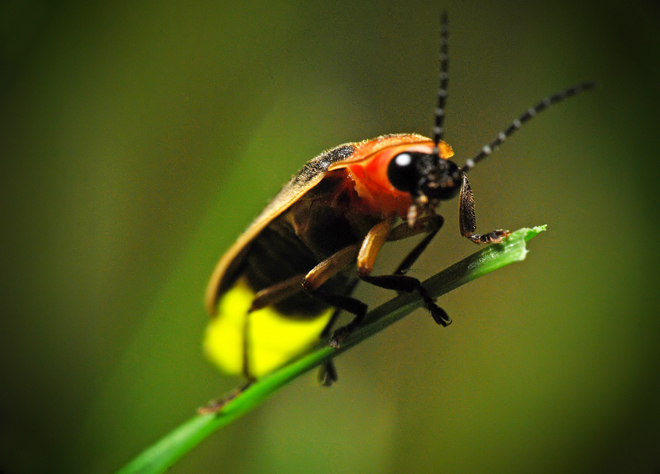Team:Cambridge/Bioluminescence
From 2010.igem.org

Project Firefly focussed on the construction of standalone light-generating BioBricks from genes involved in the light-producing pathways found in fireflies.
Fireflies in nature
Fireflies are one of the few animals on this planet equipped with the fascinating ability to emit light. They are insects from the family of click beetles and are thought to use the production of light for different purposes at distinct developmental stages. The glow of firefly larvae is thought to be an aposematic signal, advising predators of the glowworms bitter taste and toxicity. In contrast, adult fireflies use bioluminescence in courtship displays. Females respond to the flash patterns emitted by flying males with the generation of an attracting light flash from their own bodies. The chemical reactions that lead to the production of light occur in a specialised organ in the lower abdomen of fireflies, known as the lantern. Here the enzyme luciferase catalyses the oxidation of the pigment luciferin to oxyluciferin. Oxyluciferin is initially produced in an unstable chemically excited state, but quickly drops down into the more energetically favourable ground state. In this process a photon of light is emitted. In 2001 [http://www.ncbi.nlm.nih.gov/pubmed/11457857 Gomi and Kajiyama] discovered another important enzyme involved the light-producing pathway in the lantern organ of fireflies. This luciferin-regenerating enzyme (LRE) is capable of converting oxyluciferin back into luciferin upon the addition of D-cysteine, thereby relieving inhibition of luciferase by oxyluciferin as well as fueling into the luciferin pool.
Our work
In our experimental efforts we have concentrated on constructing Biobricks based on the following enzymes:
- The luciferase and LRE from the North American firefly, Photinus pyralis.
- The luciferase and LRE from the Japanese firefly, Luciola cruciata.
The luciferase from the North American firefly, Photinus pyralis, is a well-tested and characterised enzyme that has found applications in several reporter assays in scientific research. We were aware that a luciferase from this organism was already present in the Registry ([http://partsregistry.org/Part:BBa_I712019 BBa_I712019]). We aimed to improve this part and to extend its applicability by pursuing the following three different routes:
- Codon optimisation for expression in E. coli to increase the rate of translation in the bacterium
- Mutagenesis to increase substrate affinity, thereby increasing the brightness of the emitted light
- Simultaneous expression of the Photinus pyralis LRE to increasing both intensity and duration of light emission
Japanese fireflies of the species Luciola cruciata are notable for synchronising their flash patterns when in large groups, thereby making the trees on which they sit pulsate with green light. This phenomenon has been reported to be exploited by fisherman as a means of locating the shore. We wanted to add to the pre-existing luciferase in the Registry by
- Single amino acid mutagenesis to create BioBricks capable of emitting light of a range of different colours.
Luciola cruciata was specifically chosen for this purpose on the basis of a publication by Kajiyama and Nakano in 1991 that described a suite of single amino acid changes which significantly changed the wavelength of peak emission.
Project Firefly was dedicated to constructing BioBricks from genes involved in the light producing pathway found in fireflies. This pathway contains the enzyme luciferase which catalyses the production of light as well as a luciferin-regenerating enzyme (LRE) required for the conversion of oxyluciferin to luciferin.
Fireflies in nature
Fireflies are some of the best known insects from the family of click beetles. They have a light-emitting organ in their abdomen known as the lantern. This organ contains the enzyme luciferase. In terms of energy usage, this light is the most efficient light in the world. The fireflies use their lantern in courtship displays, the flashing of a female's lantern attracts males. However, larvae of certain species also glow. These larvae are known as glowworms and the light is thought to be an aposematic signal, advising predators of the beetle's bitter taste.
Our work
We have exploited a number of enzymes required for firefly bioluminescence:
- The luciferase (light emitting enzyme) from the North American firefly, Photinus pyralis with three mutations to increase substrate affinity and thereby brightness.
- The luciferase from the Japansese firefly, Luciola cruciata for which we made a number of mutations to give 3 different colours.
- The luciferin-regenerating enzymes (LREs) from both these species. Luciferin is the substrate used by firefly luciferases to emit light. Once a photon has been emitted this luciferin is released in an inactive from known as oxyluciferin. LRE is crucial for the regeneration of luciferin from this oxyluciferin.
The luciferase from the North American firefly, P. pyralis, is a well-tested and characterised enzyme catalysing the creation of light using D-luciferin as a substrate. We were aware that a luciferase from this organism was already present in the registry ([http://partsregistry.org/Part:BBa_I712019 BBa_I712019]). In order to improve this part and to further its applicability, we pursued three different routes:
- Codon optimisation for expression in E. coli to increase the rate of translation in E.coli.
- Creating a mutant with increased substrate affinity
- Parallel use of the Photinus pyralis luciferin regenerating enzyme to both relieve inhibition by oxyluciferin and increase availability of luciferin.
The Japanese firefly, Luciola cruciata is notable in that nearby fireflies flash in synchrony, making the trees pulsate with green light, a phenomenon used by fishermen as a means of locating the shore. We selected Luciola cruciata because [http://www.ncbi.nlm.nih.gov/pubmed/1946326 Kajiyama and Nakano (1991)] had described a suite of single amino acid changes which significantly changed the wavelength of peak emission.
 "
"

